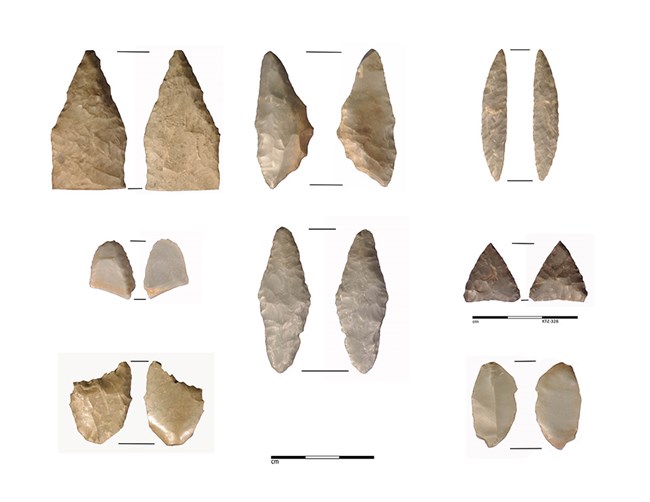Last updated: June 24, 2019
Article
Arctic Small Tool Tradition

Traditionally people in northern Alaska have practiced a maritime economy. Life in the Arctic would be nearly impossible without a keen knowledge of how to harvest resources such as seals, walrus, and whales from the sea. A major archaeological research problem in Alaska concerns the timing and development of the Eskimo maritime economy.
Scientists believe that the earliest maritime culture found in northern Alaska was from people bearing tools of the Arctic Small Tool tradition (ASTt), referred to locally as the Denbigh Flint complex. The ASTt appears in Alaska around 5,000 years ago and soon after is found across the North American Arctic all the way to Greenland.
New evidence for the timing of Arctic Small Tool tradition coastal settlement in northwest Alaska
Abstract
This paper presents the results of a survey of the oldest beach ridges located on Cape Espenberg in Bering Land Bridge National Preserve, Alaska. The goals were to locate and test Arctic Small Tool tradition (ASTt) sites to develop a coastal settlement chronology and to establish whether marine resources were exploited. At the outset of this project four ASTt sites were known at Cape Espenberg, two with associated radiocarbon dates. Upon completion, ten new ASTt sites with eleven radiocar-bon dates were added to the record. Analysis of the radiocarbon dates indicate ASTt occupations at Cape Espenberg began at least 4,500 years ago and lasted a millennium. Comparisons among ASTt sites throughout Alaska suggest the coast was settled prior to the interior. The site designated KTZ-325 yielded the oldest securely dated evidence for sea mammal use in Northwest Alaska, supporting the hypothesis that ASTt people had a maritime economy in place at the start of their florescence in Alaska and beyond.
Tremayne, A. 2016. New Evidence for the timing of Arctic small tool tradition coastal settlement in northwest Alaska. Alaska Journal of Anthropology 13:1-18.
The design of Arctic Small Tool tradition toolkits: an example from Matcharak Lake, Alaska
Abstract
This article presents the results of an analysis of stone tools and debitage from a 3600–4000 cal BP Arctic Small Tool tradition (ASTt) component at Matcharak Lake (AMR-186), located in the Alaskan Brooks Range. The goal of this study is to understand how ASTt technology is organized at a caribou hunting camp located far from a high quality toolstone source, and to use this information to evaluate ASTt mobility and settlement patterns in northern Alaska. Reconstructions of the stone-tool reduction sequences demonstrate that ASTt people made use of blade and biface technologies, but they primarily transported small finished tools and biface cores to produce large flakes for tool blanks and microblade cores. The stone-tool assemblage recovered from at Matcharak Lake is one designed to maximize utility, transportability, and relatively rapid production, which is an adaptive feature of a culture that has high residential mobility in an environment with limited access to raw material sources and an economy specialized on caribou.
Tremayne, A. H. 2015. The design of Arctic Small Tool tradition toolkits: an example from Matcharak Lake, Alaska. North American Archaeologist 36(1):1-31.
Marine resource intensification and the reorganization of lithic technologies during the Middle-Late Holocene in Northwest Alaska
Abstract
This study uses lithic technological organization from two successive Middle–Late Holocene archaeological cultures in northwest Alaska to test hypotheses about marine resource intensification through time. Researchers argue that maritime adaptations in northwest Alaska progressed from supplementary seasonal exploitation towards a highly complex, year-round reliance on marine resources. Robust faunal assemblages and organic technologies necessary to demonstrate this developmental transformation are generally lacking in sites from this time period. Instead, our primary sources of data are site locations, features, and lithic technology. Theorists have shown that technological organization, including lithic components, is greatly influenced by subsistence strategy and residential mobility. In theory, an increased reliance on marine resources should result in increased technological complexity, greater use of local raw materials, and overall less concern with optimizing size and weight of tools. I test these hypotheses using Arctic Small Tool and Norton tradition lithic assemblages from the stratified, multi-component site of Iyatayet, located in northwest Alaska. The results indicate technological organization of the later culture differed in many important ways from the earlier group, supporting interpretations of reduced mobility and a greater reliance on resources from the sea through time.
Tremayne, A. H. 2017. Marine resource intensification and the reorganization of lithic technologies during the middle-late Holocene in northwest Alaska. Journal of Island and Coastal Archaeology 0:1-17.
Large mammal biomass predicts the changing distribution of hunter-gatherer settlements in mid-late Holocene Alaska
Abstract
This study provides an ecological explanation for the distribution of Arctic Small Tool tradition (ASTt) settlements in Alaska and the origin of their arctic maritime adaptation. Theoretically grounded in the ideal free distribution (IFD) model, which predicts that higher ranked habitats will be occupied first and most continuously, we contend that the location of large mammals was a major factor influencing human dispersal and settlement decisions in the arctic and subarctic ecosystems of Alaska. We rank habitat suitability based on historic mammal population densities from wildlife ecology reports across predefined ecological zones in Alaska; we multiply densities by average animal weights per species to determine suitability rankings. Coastal habitats in Alaska are higher ranked than adjacent tundra habitats, but the interior boreal forest may have been the highest ranked, considering technological constraints of hunting aquatic species. The ASTt migration into Alaska created population pressure that promoted the colonization of the unoccupied Arctic coast and development of the dual, terrestrial-maritime economy. When pan-Alaska human populations declined around 3200–2500 years ago low ranked tundra ecoregions were abandoned. As human populations recovered Alaska coasts became the most densely populated habitats. The adaptive logic entailed in the IFD provides a consistent evolutionary interpretation for settlement patterns documented in this region.
Tremayne, A. H. and B. Winterhalder. 2017. Large mammal biomass predicts the changing distribution of hunter-gatherer settlements in midlate Holocene Alaska. Journal of Anthropological Archaeology 45:81-97.
